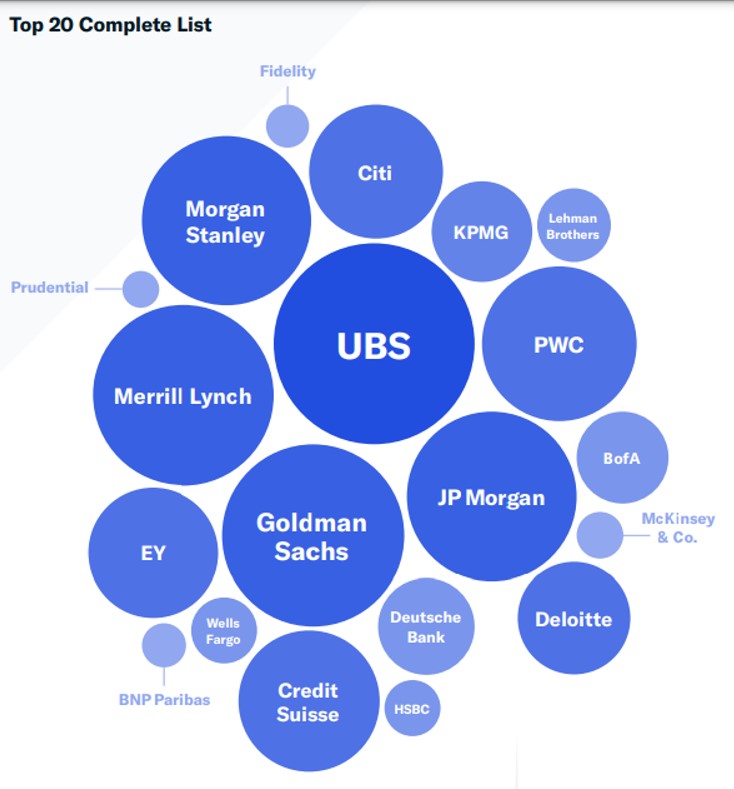Family Office
Family Offices Remain Overwhelmingly Male-Dominated - Study

The family office industry remains male-dominated, but those who work in it aren't perhaps as old as might be assumed. A new report seeks to illuminate the population characteristics of people who toil in the industry.
(Repeat of article previously published on Family Wealth Report, sister news service to this one.)
North American family offices have slightly more investment
professionals than is the case with peers in other regions, and
aren’t as male-dominated, although the sector has a way to go
before becoming more diverse, new figures show.
The 23-page study, produced by FINTRX, a family office data,
research, and intelligence platform, sponsored by Charles Schwab, also
shows that North American family office professionals are a touch
older on average (45 years) than their counterparts; the most
common qualification for investment personnel is the CFA, and
those practising in North America tend to have seats on the
boards of more external firms than their peers elsewhere.
Globally, 81.1 per cent of family office professionals are men;
83.6 per cent of C-suite professionals at FOs are men, and men
account for 86.8 per cent of FO investment committee members. In
the US the figures are 79.4 per cent, 80.9 per cent and 86.2 per
cent, respectively. For Europe, the figures are 85.6 per cent;
91.2 per cent, and 88.7 per cent. In Asia and the Middle East,
figures are 80.7 per cent, 87.4 per cent and 90.5 per cent.
The findings, drawn from thousands of individuals on the FINTRX
database, are contained in a report entitled Part Three:
Family Office Professionals. The report follows earlier
studies such as family offices’ direct
investment habits. FINTRX is an example of the kind of
business tracking family offices; other examples include Highworth
Research, a UK-based organisation. (Click
here to register on the Highworth database. This news service
has an exclusive media partnership with that group.)
The industry needs to adjust as Millennials inherit and build
wealth in new economic sectors, and bring different attitudes
towards work and gender equality.
What surprised the providers of this report?
“The surprise was that US-based family office professionals hold
more board seats on other companies than is the case in others
parts of the world,” Russ D’Argento, FINTRX founder, told this
news service last week. He explained that North American FOs
are particularly keen director investors, which drives the need
for board seats.
The dominance of men in investment roles is striking.
“We continue to see that the discrepancy is decreasing,”
D’Argento said. “It was pretty much what I expected – it [the
industry] is male-dominated.”
Jill Matesic of Schwab Advisor Family Office, added: “We
recognise as an industry that we need to do better in terms of
attracting and retaining diverse talent. Schwab was founded on
Chuck’s vision of inclusion of all investors. That spirit of
inclusiveness is at the heart of all that we do, both within
Schwab and in support of the advisors and clients we serve.”
Figures showed that North American FOs, both multi-family offices
and single-family offices, employ an average of 4.1 investment
professionals; in Asia/Middle East, where the sector is less
mature, the figure is 3.1 per cent; and in Europe, it is 3.5 per
cent.
One aspect of the results is that figures suggest that people
tend to move around in MFOs more than they do in single-family
offices. “MFO professionals tend to be more transient. It appears
people settle into single-family offices as a career decision,”
D’Argento said. “Single family offices are really stepping up
their game in poaching talent.”
Looking younger
Family office investment professionals are on average 42 years
old; in the US the age is 45, it is 41 in Europe, 42 in
Asia/Middle East and 40 in other countries. With so much of the
newer family offices being set up by tech sector entrepreneurs
who have sold or floated businesses on the stock exchange, the
relatively “young” profile makes sense, D’Argento said.
The report also tracks the educational institutions that
penetrate financial offices the most in terms of graduates.
Perhaps unsurprisingly, Harvard, University of Pennsylvania and
Columbia make up the top three. There is a “strong correlation”
between the location of the family office and the schools from
which the talent has graduated. (Other prominent universities in
the mix are New York University; Stanford; The University of
Texas at Austin; The University of Chicago; University of
Michigan; UCLA; Yale; Boston University; and the University of
Oxford (UK).)
As far as where FO professionals have worked previously, the
largest former firm is UBS, while Merrill Lynch, Goldman Sachs,
JP Morgan and Morgan Stanley are also prominent. EY and PwC are
also significant channels of talent into the FO space.
“Over the past decade, these entities have increasingly pursued
industry leaders to assist in their investment research and
execution. As the family office market has greatly expanded, so
too has the complexity of their investment activities. With the
understanding that hiring top industry professionals opens a
number of doors with regard to investment opportunities, family
offices continue to attract the highest industry talent,” the
study said.

The report also tracked how many FO professionals have a military
background. The South of the US has the most in relative terms –
4.4 per cent, while the Northeast has the lowest – 2.7 per cent.
The West Coast has 3.8 per cent and Midwest has 3.3. per
cent.
Professionals working in single-family offices work on average
for nine years at such places, while the result is lower at
multi-family offices (six years). Europe has the longest tenures
for SFOs (13 years) and the US has the lowest (7 years).